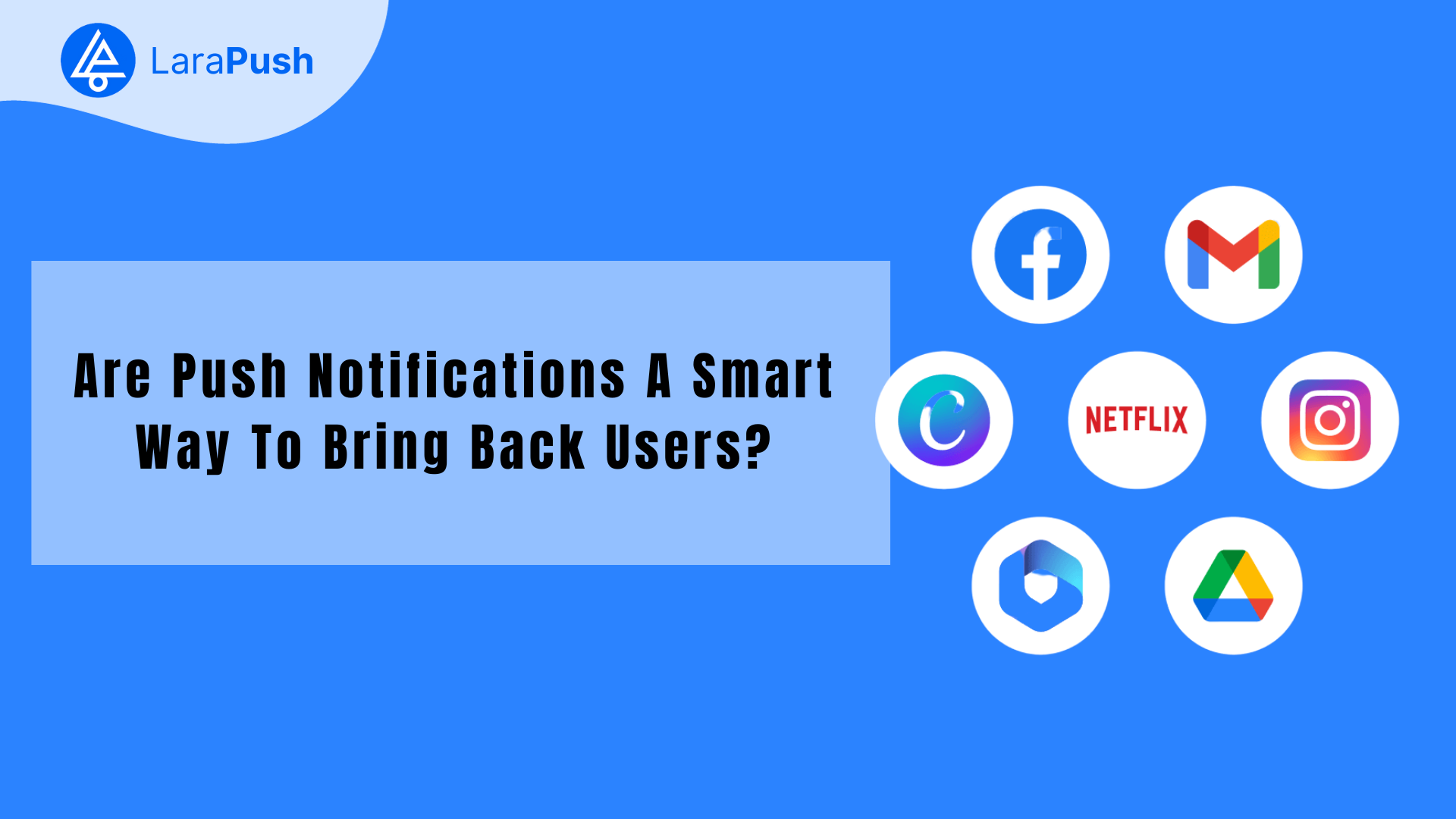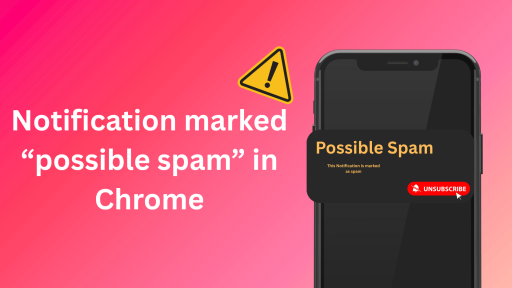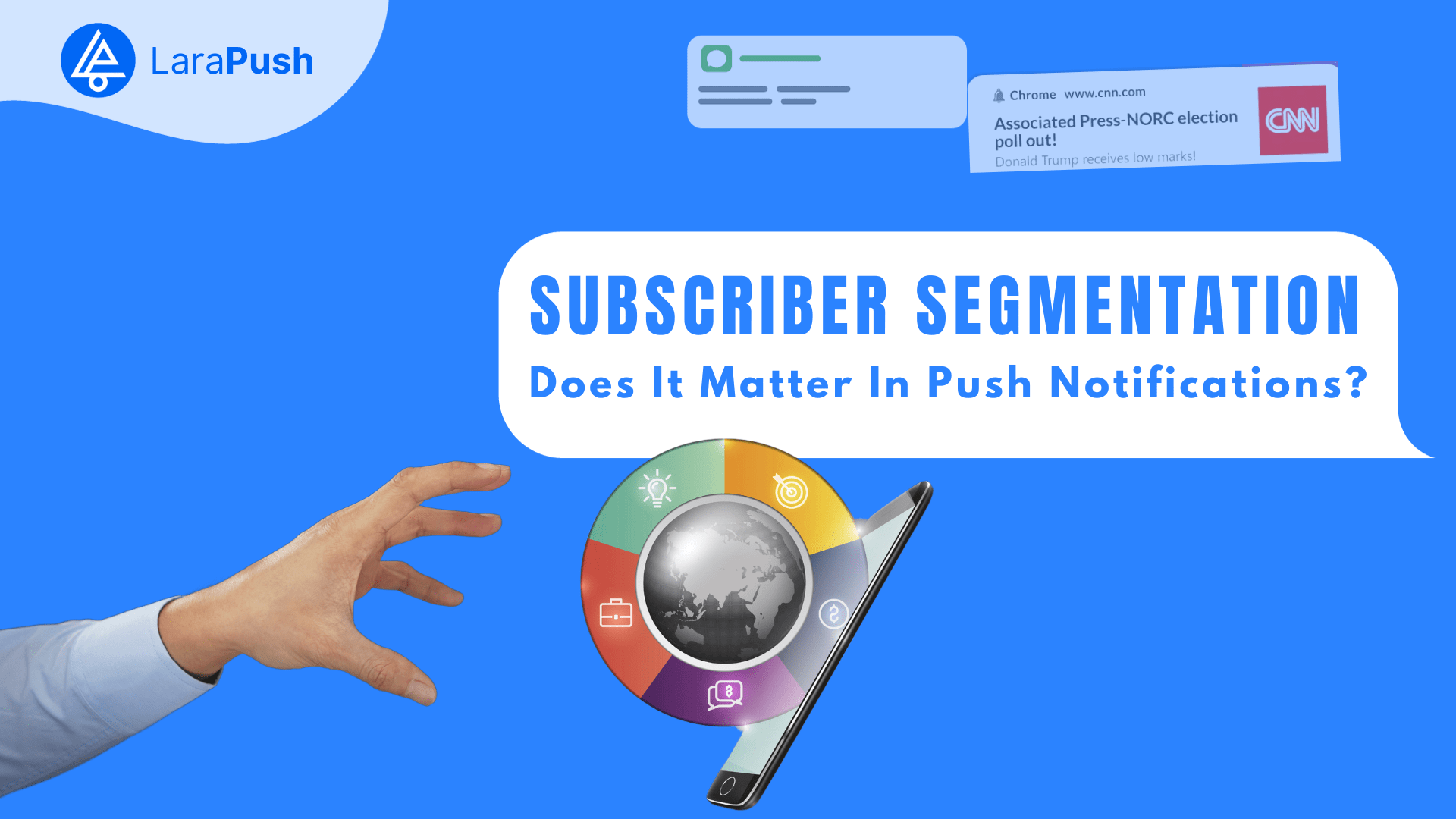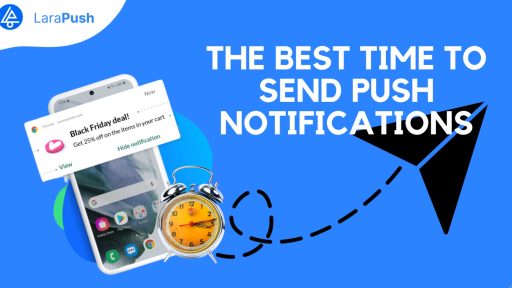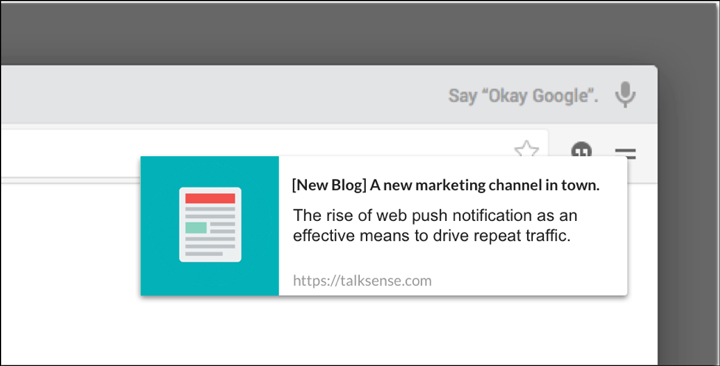Web push notifications are undoubtedly the best user retention methods, but using them alone isn’t efficient for user re-engagement as you’ll have to apply some additional strategies to make this method work.
In this blog we will explore the importance of user re-engagement and the best strategies for user re-engagement using push notifications.
What is User Re-Engagement?
User re-engagement is a phenomenon where you try to engage users who have previously interacted with a product, service, app, or website. It includes strategies to bring back their interest in your business.
It is a way to retain an audience who might have lost interest.
How do Push Notifications help in Re-Engaging your visitors?
Push notifications notify users through personalized messages directly to their devices, informing them about your business, updates, or something else.
It helps to keep the communication between your visitors and business active, which makes them feel connected to your brand.
With the right strategic and well-crafted messages, you can use push notifications to re-engage the audience, drive traffic, and ultimately boost conversions for websites and applications.
When to use Push Notifications to bring back visitors?
Before you start bombarding your audience with notifications, it’s important to understand when and where push notifications work the best.
Businesses send push notifications during the following period –
New Content or Features
Whether you have a blogging website or a business website, you would definitely want your subscribers to know about recent posts, content, or features. You can easily notify them with push notifications mentioning why they cannot afford to miss out the update.
Offers or Promotions
Are you giving out offers on special occasions? If yes, you should let your subscribers know about limited-time offers and flash sales through notifications on their phones.
Not only your existing customers will get benefits from the offers, but they will also bring in new customers.
Abandoned Carts or Incomplete Actions
Sending push notifications when a user abandons a cart or leaves a process incomplete (such as filling out a form or starting a purchase) can prompt them to return and complete the action.
Offering incentives like discounts or free shipping can be effective in encouraging users to finalize their transactions.
Event Reminders or Important Updates
Push notifications can serve as reminders for upcoming events, webinars, or appointments, keeping users informed and engaged.
Additionally, notifying users about critical updates, such as changes in policies, service interruptions, or important announcements, can prompt them to revisit the website for more information or to take necessary actions.
Things to consider while Sending Push Notifications
Here are some essential things to consider when sending push notifications to visitors:
- Personalise and Segment: Tailor your push notifications based on user behavior, preferences, and demographics. Segmentation allows for more targeted and relevant messages, increasing the chances of engagement.
- Provide Value: Ensure that your notifications offer valuable information, such as personalized recommendations, exclusive deals, or relevant updates. Deliver content that aligns with users’ interests to encourage interaction.
- Optimise Timing: Be mindful of the timing of your notifications. Sending them at appropriate times, such as during peak activity periods or based on the user’s time zone, enhances the likelihood of engagement.
- Use Clear and Compelling Copy: Craft concise, compelling, and action-oriented copy for your notifications. Clearly communicate the benefit or purpose of the message to prompt users to take the desired action.
- Test and Analyze: A/B tests different notification formats, timing, and content to identify what works best for your audience. Analyze the performance metrics to refine your strategy continuously.
The Don’ts while Sending Push Notifications to Visitors
- Too Many Notifications: Avoid bombarding users with excessive notifications, as this can lead to annoyance and prompt them to disable notifications or uninstall your app.
- Ignoring Opt-Out Preferences: Respect users’ preferences by providing easy options to opt out of notifications. Ignoring opt-out requests can lead to a negative user experience.
- Being Intrusive or Pushy: Push notifications should not be intrusive or overly aggressive. Respect users’ space and avoid using pushy language that might deter them from engaging with your content.
- Ignoring User Behaviour: Avoid sending notifications that contradict a user’s previous actions or preferences. For instance, sending a promotion for a product a user has already purchased can lead to frustration and decrease engagement.
- Lack of Clear Call-to-Action (CTA): Notifications without a clear call-to-action might confuse users about what action to take. Ensure that your message clearly directs users on what steps to follow after receiving the notification.
- Being Vague or Misleading: Avoid using vague or misleading information in your notifications. Clear and accurate messaging builds trust, while misleading content can lead to distrust and negatively impact your brand’s reputation.
What to do after Sending Push Notifications?
Here are a few things you should do after sending push notifications to get the best out of your campaigns –
Analyze Engagement Metrics
After sending push notifications, the first step is to gather and analyze engagement metrics. It includes tracking open rates, click-through rates, conversion rates, and user responses.
Analyzing these metrics helps in understanding user behavior, preferences, and the effectiveness of the notification campaign. It provides insights into what types of messages, timing, or content resonate best with your audience.
Adjust Strategies Based on Metrics
Using the insights gained from engagement metrics, businesses can adjust their strategies to optimize future push notification campaigns.
For instance, if certain messages or timing resulted in higher engagement rates, those strategies can be replicated for similar campaigns.
Conversely, if specific notifications received poor responses or high opt-out rates, adjustments can be made to improve messaging, timing, or targeting.
User feedback is also invaluable; it might be obtained through surveys, reviews, or direct communication. Understanding user preferences and responses enables businesses to refine their approach and create more personalized, relevant, and effective notifications.
Implement Follow-Up Actions
Following the analysis and adjustments, businesses can implement follow-up actions to continue re-engaging users. This could involve strategies such as sending targeted follow-up notifications based on previous interactions, offering exclusive incentives or personalized content, or introducing new features or updates aligned with user interests.
These follow-up actions aim to maintain ongoing engagement and nurture relationships with users, ultimately driving them back to your website or app. Continual efforts to re-engage users are essential for sustaining interest and loyalty over time.
Top Brands That Have Aced Re-Engagement with Push Notifications
Here, we have covered some great examples from the top brands that are killing user re-engagement with push notifications –
Zomato
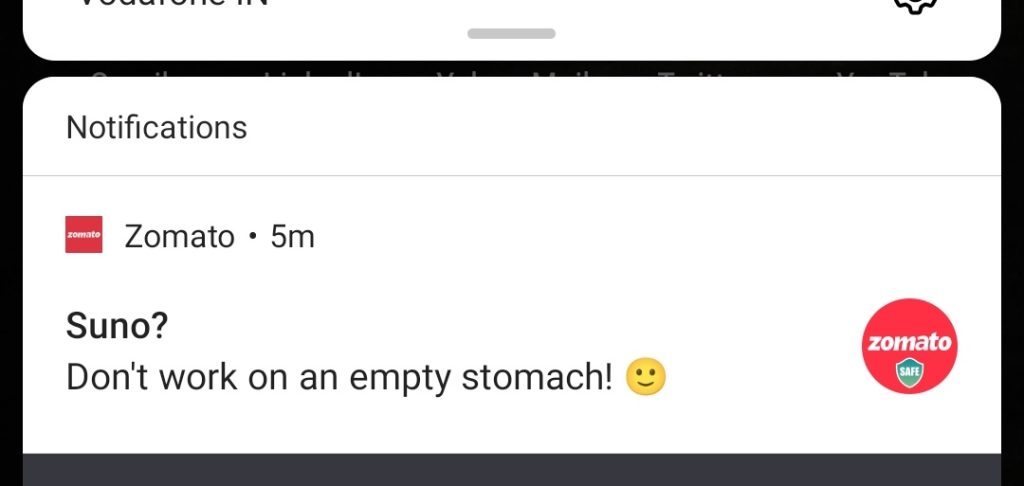
Have you ever received notifications like
“Suno? Don’t work on an empty stomach!”
or the epic
“A hard day’s work….. calls for a fulfilling meal to end the day with!”
That’s zomato’s push notification to users.
Here’s how Zomato is at the top of the game when it comes to push notifications:
- Targeted Timing: Have you ever wondered how you get workday notifications just after you leave the office? Well, that’s because Zomato has spent a lot of time studying its audience. Their timing strategy aligns with user behavior, increasing the likelihood of conversions.
- Personalization: This is another cool notification from Zomato: “Coffee is great! But you still need food, Swati! Don’t skip meals over coffee and tea—go have lunch!” Most of their notifications address you with your name, which adds a personal touch.
- Visuals and Emojis: Zomato understands the impact of visuals. It includes relevant images alongside compelling content in its push notifications. Zomato doesn’t shy away from using emojis. It always adds a playful and relatable tone to its messages with emojis.
CNN
If you think push notifications are only for businesses with products or services you have got it all wrong. It also drives traffic for blogs.
Don’t believe us? See how CNN has re-engaged thousands of visitors to its website through a new blog update.
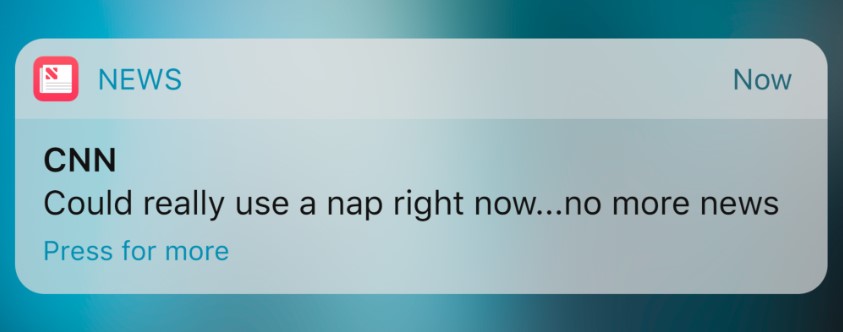
- Real-Time Updates: CNN understands the significance of keeping readers informed as news breaks. They leverage web push notifications to instantly deliver breaking news, ensuring that users are among the first to know about important events or developments. This immediacy creates a sense of exclusivity and value for the users.
- Engaging Headlines: Crafting compelling and concise headlines is crucial for enticing users to click on push notifications. CNN makes efforts to create attention-grabbing headlines that pique users’ curiosity, prompting them to click through and read the full story on their website.
- Call-to-Action (CTA): Including a clear and compelling call-to-action within the push notification encourages users to take immediate action, such as clicking to read the full story or watch a video related to the breaking news.
Amazon
First thing first, Amazon has aced cart abandonment through well-crafted push notifications. These notifications serve as reminders to users who have left items in their cart, enticing them to return and complete the purchase. This strategy is effective in reducing abandonment rates and increasing conversion rates.
Amazon’s push notifications work in conjunction with its sophisticated product recommendation engine. These notifications leverage user browsing and purchasing history to suggest relevant products. This personalized approach encourages users to return to the app by showcasing items aligned with their interests and previous buying behavior.
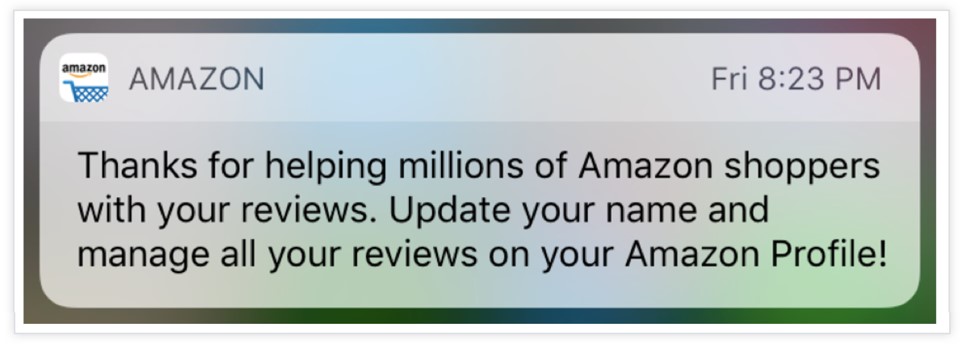
Moreover, Amazon has tapped into its user’s minds to uncover their preferences. Their push notifications are targeted to specific demographics, age groups, and more. For example, in their push notifications campaigns that are tailored for parents they send specifically back-to-school shopping reminders. Not to mention their impeccable timing of sending push notifications.
How LaraPush Can Help You Re-Engage Visitor Effortlessly!
LaraPush revolutionizes visitor re-engagement effortlessly!
With a one-time cost, this self-hosted push notification panel offers unlimited domains, subscribers, and campaigns indefinitely.
Boasting an array of industry-leading features, LaraPush ensures no limitations hinder your engagement strategy. Its WordPress plugin simplifies push notifications upon publishing. Experience lightning-fast delivery surpassing SAAS solutions.
